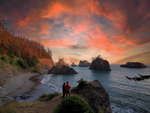It's one of the most mysterious ancient rock art sites in the American Southwest. Haunting images depicting limbless human-like figures with hollowed out eyes and strange looking antennae blanket the sandstone walls of southern Utah's Thompson Canyon. Formally known as Sego Canyon Interpretive Site, the ghostly figures found here were created during the Archaic period (8000 BC to 500 BC) by artists belonging to the nomadic hunter-gatherer peoples who inhabited the region thousands of years ago. The pictographs are so bizarre that they were once featured on History Channel's Ancient Aliens where Giorgio Tsoukalos proclaimed that the ancient natives must have created the rock art to commemorate a visit from extraterrestrials. The wacky hair guy is probably a bit off his rocker with that claim, but nevertheless, the images are incredibly strange. Further down the canyon, evidence that the area was once inhabited by two, more present Native American cultures exists. The artists of these cultures also used the walls of the canyon as their canvases, crafting intricate petroglyphs, which detailed their lives. It's a fascinating site located forty minutes north of Arches National Park and just over an hour from Goblin Valley State Park, making it a great excursion when visiting either area.


Trailhead elevation 5,500'
Water None
Don't miss the backcountry campsite nearby
Visiting Sego Canyon
One of the most striking aspects of the rock art in Sego Canyon is its diversity. The art includes images from several different cultural periods, spanning from the prehistoric era to the more recent past. Some of the images date back to the Archaic period, which lasted from around 8,000 BC to 500 BC. Other images are from the Fremont culture, which lived in the region from around 500 AD to 1300 AD. The art also includes images from the Ute people, who inhabited the region from around 1300 AD to the near present day.
The Barrier Canyon style pictographs belonging to the Archaic period are the most easily identifiable and oldest rock art in Sego Canyon. The most intriguing panel, featuring nearly thirty depictions of shamans holding ceremonial staffs and snakes, and other anthropomorphic figures, is situated atop a ledge twenty feet above ground level on the west side of the canyon.

The images on this panel vary in size, with some as small as eighteen inches and others towering over four feet tall. Some of the figures appear to have antennae or headdresses and most have hollowed eyes.

All were painted using red ochre, a natural pigment composed of ferric oxide, sand, and clay.

The rock art style known as Barrier Canyon derives its name from a site we know today as Horseshoe Canyon in Canyonlands National Park. Before being named Horseshoe Canyon, and well before it became part of the national park, archaeologists and ranchers recognized it as Barrier Canyon after the creek that flows through it. In her 1971 book "Rock Art of Utah," archaeologist Polly Schaafsma coined the term Barrier Canyon style while discussing the rock art found in Horseshoe Canyon. Since then, the limbless, often vacant eyed pictographs of Horseshoe Canyon, Sego Canyon, and countless other sites throughout southern Utah have been identified as Barrier Canyon style.

On the east side of the canyon, at ground level, there are several more panels from the same period. The southernmost, which is located on private property and fenced off, displays no less than ten images that are similar to those on the western panel. Among the depictions, there are two that exhibit ornamental headdresses, one of which appears to have horns. Despite the presence of vandalism, the panel remains in overall good shape.

More images can be found to the left of this panel, including concentric circles, an animal, and a number of anthropomorphic figures.

Along the same wall you'll also find many petroglyphs from a later period in time, including many animals, anthropomorphic figures, footprints, and other unknown depictions. As you can see, this area has been heavily vandalized.

Continuing along the same side of the canyon you'll discover another great panel, including images of anthropomorphic figures, several with what appear to be ceremonial headdresses, and various other depictions.

The last and northernmost image on the east side of the canyon is a large sawtooth pictograph with a snake above it. Snake depictions above or inside sawtooth pictographs are fairly common in the region.

Sometime between 500 AD and 1300 AD, centuries, if not millennia, after the Archaic peoples, the Fremont culture inhabited the region and left their own contributions in Sego Canyon. Artists of this period used the rock surfaces here to etch petroglyphs into the cliffs adjacent to Thompson wash. Among the petroglyphs are depictions of human-like figures with ornate clothing and headdresses, various animals, a hunt scene, and more. The panel below is on the west side of the canyon, just around the corner from the main pictograph panel, and features many Fremont era petroglyphs below much older Barrier Canyon style pictographs.

Like the Barrier Canyon style pictograph panels, the Fremont petroglyphs have experienced a fair amount of vandalism over the years, but remain in overall good condition.

At some point between 1300 AD and the late 1800's, the Ute inhabited Sego Canyon and further added to the canyon's collection of ancient art. Petroglyphs of colorful shields, human-like figures, various animals, and more can be found along the cliffs adjacent to Thompson Wash.

The presence of petroglyphs depicting horses, which were introduced to the continent by Spanish conquistadors in the late 1400s, appear on several panels, further leading archaeologists to surmise that they were created by the Ute.

For those looking to sleep under the stars, there is a backcountry campsite beside the road just north of the rock art sites. You'll be right along the road, but the area gets very little, if any traffic at night. There's already a stone fire ring there and can accommodate up to two tents.
_edited.png)






















